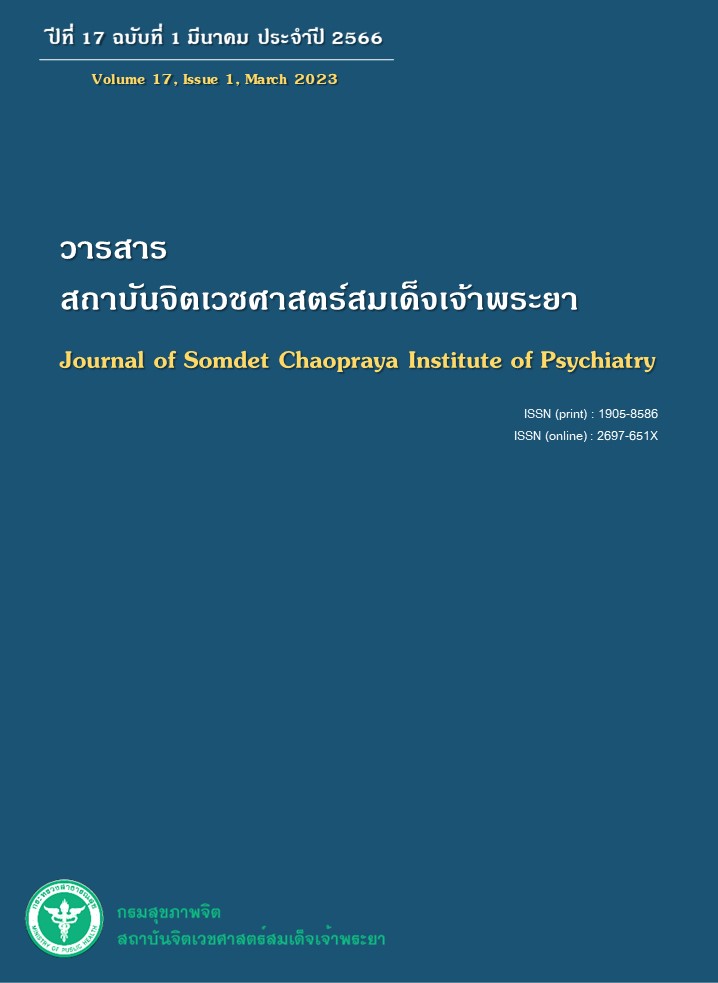ประสบการณ์การพยายามฆ่าตัวตายของผู้ป่วยโรคซึมเศร้าในสถาบันจิตเวชศาสตร์สมเด็จเจ้าพระยา : แรงจูงใจและความตั้งใจ
คำสำคัญ:
ประสบการณ์, แรงจูงใจ, ความตั้งใจ, การพยายามฆ่าตัวตาย, โรคซึมเศร้าบทคัดย่อ
วัตถุประสงค์ : เพื่ออธิบายเกี่ยวกับแรงจูงใจ และความตั้งใจในการฆ่าตัวตายของผู้ป่วยโรคซึมเศร้า
วัสดุและวิธีการ : การศึกษาครั้งนี้เป็นการวิจัยเชิงคุณภาพตามแนวคิดปรากฎการณ์วิทยา ผู้ให้ข้อมูลเป็นผู้ป่วยโรคซึมเศร้าที่มีประวัติฆ่าตัวตายภายใน 1 เดือน เป็นผู้ป่วยในของสถาบันจิตเวชศาสตร์สมเด็จเจ้าพระยา จำนวน 10 คน เก็บรวบรวมข้อมูลในเดือนมีนาคม - สิงหาคม พ.ศ. 2565 ใช้การสัมภาษณ์เชิงลึก วิเคราะห์ข้อมูลด้วยวิธีวิจัยเชิงคุณภาพ
ผล : แรงจูงใจในการฆ่าตัวตาย พบว่าผู้ป่วยเผชิญกับ (1) เหตุการณ์ความเครียดในชีวิต ได้แก่ ความขัดแย้งกับสมาชิกในครอบครัว การถูกตีตราเป็นผู้ป่วยจิตเวช การสูญเสียบุคคลอันเป็นที่รักหรือสิ่งที่รัก ภาระหนี้สิน/ค่าใช้จ่ายการเงิน (2) มีความคิดต่อตนเองเชิงลบ ได้แก่ คิดว่าตนเป็นภาระ คิดว่าถูกทอดทิ้ง คิดว่าหมดหนทาง คิดว่าตนเองไม่ดี (3) มีอารมณ์ซึมเศร้า หรืออารมณ์ซึมเศร้าร่วมกับความรู้สึกโกรธ หรือตื่นตระหนก ส่วนความตั้งใจในการฆ่าตัวตาย พบว่า (1) ผู้ป่วยเคยพยายามฆ่าตัวตายมาก่อน (2) เลือกวิธีการฆ่าตัวตายที่คุ้นเคยหรือใกล้ตัว (3) มีทั้งการวางแผนล่วงหน้าและไม่ได้วางแผน และให้ความหมายของการฆ่าตัวตายเชิงบวก เป็นทางออกที่ดี ความช่วยเหลือที่ผู้ป่วยได้รับ พบว่า มาจากคนในครอบครัวด้วยการพูดปลอบใจ การอยู่เป็นเพื่อน การจัดเก็บอุปกรณ์อันตราย การได้รับการบำบัดทางจิตกับผู้เชี่ยวชาญ การทำกิจกรรมออกกำลังกาย สิ่งที่ช่วยลดแรงจูงใจและความตั้งใจในการฆ่าตัวตาย ได้แก่ การคิดถึงบุคคลที่ตนเองรักและรักตนเอง คิดถึงเป้าหมายในชีวิต และหลีกเลี่ยงสิ่งมึนเมาในช่วงที่มีอารมณ์ซึมเศร้า
สรุป : แรงจูงใจในการฆ่าตัวตายเป็นลักษณะความคิดที่อยากจะตาย ส่วนความตั้งใจในการฆ่าตัวตายเป็นการแสดงพฤติกรรมที่จะทำให้ตนเองตาย สิ่งสำคัญในการป้องกันการพยายามฆ่าตัวตาย คือ การปรับความคิดของผู้ป่วย และความเข้าใจของครอบครัว
เอกสารอ้างอิง
Dong M, Zeng LN, Lu L, Li XH, Ungvari GS, Ng CH, et al. Prevalence of suicide attempt in individuals with major depressive disorder: a meta-analysis of observational surveys. Psychol Med 2019; 49(10): 1691-704.
กรมสุขภาพจิต กระทรวงสาธารณสุข. คู่มือระบบการดูแลผู้ป่วยจิตเวชที่มีความเสี่ยงสูงต่อการก่อความรุนแรง สำหรับสถาบัน/ โรงพยาบาล สังกัดกรมสุขภาพจิต. นนทบุรี: พรอสเพอรัสพลัส; 2563.
Pukrittayakamee P, Ratta-apha W, Sirirat C, Singhakant S, Wannachavee U, Satra T, et al. Prevalence and associated factors of suicidal ideation among patients with major depressive disorder. J Med Assoc Thai 2022; 105(2): 85-90.
มาโนช หล่อตระกูล. การฆ่าตัวตาย: การรักษาและการป้องกัน. กรุงเทพฯ: บียอนต์ เอ็นเทอร์ไพรซ์; 2553.
สมบัติ สกุลพรรณ์. การพยาบาลผู้ที่มีพฤติกรรมการฆ่าตัวตาย. เชียงใหม่: สมาร์ท โคตติ้ง แอนด์ เซอร์วิส; 2564.
O'Connor RC, Kirtley OJ. The integrated motivational-volitional model of suicidal behaviour. Philos Trans R Soc Lond B Biol Sci 2018; 373(1754).
Husseri E. Phenomenology and the crisis of philosophy. New York: Harper & Row; 1965.
Wang Y, Sareen J, Afifi TO, Bolton SL, Johnson EA, Bolton JM. A population-based longitudinal study of recent stressful life events as risk factors for suicidal behavior in major depressive disorder. Arch Suicide Res 2015; 19(2): 202-17.
Janiri D, De Rossi P, Kotzalidis GD, Girardi P, Koukopoulos AE, Reginaldi D, et al. Psychopathological characteristics and adverse childhood events are differentially associated with suicidal ideation and suicidal acts in mood disorders. Eur Psychiatry 2018; 53: 31-6.
Alessi M, Szanto K, Dombrovski A. Motivations for attempting suicide in mid- and late-life. Int Psychogeriatr 2019; 31(1): 109-21.
Thomas SJ, Larkin T. Cognitive distortions in relation to plasma cortisol and oxytocin levels in major depressive disorder. Front Psychiatry 2019; 10: 971.
Hayashi N, Igarashi M, Imai A, Yoshizawa Y, Asamura K, Ishikawa Y, et al. Motivation factors for suicidal behavior and their clinical relevance in admitted psychiatric patients. PloS one 2017; 12(4): e0176565.
Heuschen C, Mocking RJT, Zantvoord JB, Figueroa CA, Schene AH, Denys D, et al. Suicidal ideation in remitted major depressive disorder predicts recurrence. J Psychiatr Res 2022; 151: 65-72.
Xin LM, Chen L, Su YA, Yang FD, Wang G, Fang YR, et al. Risk factors for recent suicide attempts in major Depressive disorder patients in China: results from a national study. Front Psychiatry 2018; 9: 300.
Park S, Hatim SA, Srisurapanont M, Chang SM, Liu CY, Bautista D, et al. The association of suicide risk with negative life events and social support according to gender in Asian patients with major depressive disorder. Psychiatry Res 2015; 228(3): 277-82.
Jha MK, Fava M, Minhajuddin A, Chin Fatt C, Mischoulon D, Cusin C, et al. Association of anger attacks with suicidal ideation in adults with major depressive disorder: Findings from the EMBARC study. Depress Anxiety 2021; 38(1): 57-66.
Goncalves PA, Lopez MM, deAzevedo CT, Campos MT, daSilva AR, Jansen K, deMattos DSL. Incidence and risk factors for suicide attempts in patients diagnosed with major depressive disorder. Psychol Res Behav Manag 2020; 13: 1147-57.
Belsiyal CX, Rentala S, Das A. Frequency of suicide ideation and attempts and its correlates among inpatients with depressive disorders at a tertiary care center in North India. J Family Med Prim Care 2022; 11(6): 2537-44.
Vadukapuram R, Trivedi C, Mansuri Z, Jain S. Common methods of suicide and self-inflicted poisoning/injury by individuals with major depressive disorder and bipolar disorder: a nationwide inpatient sample analysis. Prim Care Companion CNS Disord 2022; 24(4): 21m03159.
สมพร รุ่งเรืองกลกิจ, อิงคฏา โคตนารา, รัชฎาพร ธรรมน้อย, อรพิน ยอดกลาง, บุษบา อนุศักดิ์. ประสบการณ์การพยายามฆ่าตัวตาย: ความแตกต่างทางเพศภาวะ. วารสารสมาคมจิตแพทย์แห่งประเทศไทย 2556; 58(3): 245-56.
Olatunji OA, Idemudia ES, Olawa BD. Family support, self-efficacy and suicidal ideation at emerging adulthood: a mediation analysis. Int J Adolesc Youth 2020; 25(1): 920-31.
Vancampfort D, Hallgren M, Firth J, Rosenbaum S, Schuch FB, Mugisha J, et al. Physical activity and suicidal ideation: A systematic review and meta-analysis. J Affect Disord 2018; 225: 438-48.
Hu MX, Turner D, Generaal E, Bos D, Ikram MK, Ikram MA, et al. Exercise interventions for the prevention of depression: a systematic review of meta-analyses. BMC Public Health 2020; 20(1): 1255.
Conejo-Ceron S, Moreno-Peral P, Rodriguez-Morejon A, Motrico E, Navas-Campana D, Rigabert A, et al. Effectiveness of psychological and educational interventions to prevent depression in primary care: a systematic review and meta-analysis. Ann Fam Med 2017; 15(3): 262-71.
Sukhato K, Lotrakul M, Dellow A, Ittasakul P, Thakkinstian A, Anothaisintawee T. Efficacy of home-based non-pharmacological interventions for treating depression: a systematic review and network meta-analysis of randomised controlled trials. BMJ Open 2017; 7(7): e014499.
Yaseen ZS, Fisher K, Morales E, Galynker, II. Love and suicide: the structure of the Affective Intensity Rating Scale (AIRS) and its relation to suicidal behavior. PloS one 2012; 7(8): e44069.
Alves CA, Cunha MI, Antônio dos Santos M, Miasso IA, Zanetti ACG, Carvalho CJ, et al. The meaning of life after a suicide attempt. Arch Psychiatr Nurs 2022; 36: 17-23.
Dambrauskiene K, Adomaitiene V, Zalinkevicius R, Jariene G, Vilkas V, Rybakova I, et al. Can suicide attempt be related to problem drinking: cohort study. Alcohol Alcohol 2019; 54(1): 104-11.
ดาวน์โหลด
เผยแพร่แล้ว
รูปแบบการอ้างอิง
ฉบับ
ประเภทบทความ
สัญญาอนุญาต
ลิขสิทธิ์ (c) 2023 วารสารสถาบันจิตเวชศาสตร์สมเด็จเจ้าพระยา

อนุญาตภายใต้เงื่อนไข Creative Commons Attribution-NonCommercial-NoDerivatives 4.0 International License.
บทความที่ได้รับการตีพิมพ์เป็นลิขสิทธิ์ของวารสารสถาบันจิตเวชศาสตร์สมเด็จเจ้าพระยา



